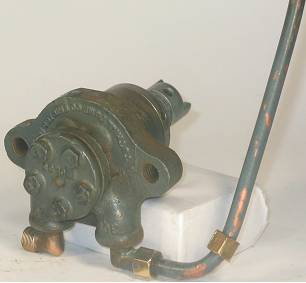Pressure Atomizing Oil Burner Equipment and Systems – Oil Pumps
A single stage rotary gear pump, with cast and machined steel body, two hole flange and barrel mount and two point drive coupling for close, direct motor drive; with original oil piping, it would be part of the 3rd wave in engineering design, characterized by compacted, fuel oil pump assemblies, Tuthill Pump Co. Chicago, Circa 1929.
Technical Significance:
From the vantage point of the early 21st century, the evolution of oil fired, automatic home heating equipment would be seen as generally advancing in four broad waves, each of which would take place over a considerable period of time, each producing many variations of the genre:
1. Vaporizing, non-motorized and non-electrified, technology [see Group 11.01 artifacts, no. 11.01-1]
2. Elemental, motorized, platform mounted technology with peripheral piping and valving components [see Group 12.01, artifact no 12.01-1, and pump assembly 12.06-1]
3. Compacted motorized technology with inherent, peripheral component parts engineered into the pump assembly [see pump assembly Group 12.06, artifact, and 12.06-2]
4. Functionally integrated, motorized technology, beyond being compacted, a number of functions would be smoothly integrated into a single pump assembly, including piping and valving [see Group 12.01, artifact 12.01-2 and pump assembly 12.06-2]
Seen here is an early, compact rotary gear pump, for close coupled, direct drive application, beginning to reflect the drive configuration to be found on the mainstream of oil burners through the balance of the 20th century.
This pump assembly stands as a late example of the 3rd wave of fuel oil pump assemblies
The close coupled, direct drive configuration used here would be an early application of the design commonly found throughout the industry to the end of the 29th century
Industrial Significance:
This requisitely crafted and machined gear, miniature gear pump would be a marvel of engineering design and production of the day
Tuthill would be widely acknowledged in the industry as an early innovator in the field, providing many of the engineering ideas, principles, products and breakthroughs which the industry would bill on – see for example ID#271.


